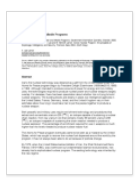Citation:

Abstract:
Iran's first nuclear technology was obtained as a gift from the United States under the Atoms for Peace program begun by President Dwight Eisenhower in 1953. Although intended to produce a source of power for energy and non-military uses, the technologies required to produce nuclear power and nuclear weapons largely overlap. For decades, there has been speculation about whether Iran is trying to build nuclear weapons. The building blocks are clearly in place, but intelligence agencies in the United States, France, Germany, Israel, and the United Kingdom vary in their estimates about how long it could take Iran to put the pieces together to produce a nuclear weapon.
Both peaceful and military uses require enrichment technology and procedures that extract and concentrate uranium-235 (235U), an isotope capable of sustaining a nuclear chain reaction, from raw uranium ore that contains mostly 99 percent uranium-238 (238U), an isotope incapable of sustaining the chain reaction needed to produce a nuclear explosion. The percentage of enrichment required for use in weapons is much higher than the levels needed to produce nuclear reactor fuel.
The Atoms for Peace program eventually came to be seen as a mistake by the United States, which has sought to recover the nuclear fuel dispersed around the world by the program. It has not always been able to do so because of political change.
By 1979, when the United States-backed dictator of Iran, the Shah Mohammed Reza Pahlavi (1919-1980), was overthrown by fundamentalist Islamist revolutionaries, Iran already had a sophisticated nuclear program. The existing technology was inherited by the new regime.
Iran has consistently insisted that its nuclear facilities and activities are intended only for the peaceful production of nuclear energy. In 2002, however, Iranian dissidents publicized the existence of secret nuclear facilities they contended were part of secret Iranian program to produce nuclear weapons. The United Nations' International Atomic Energy Agency (IAEA) began inspections of Iran's facilities later that year. (more)
